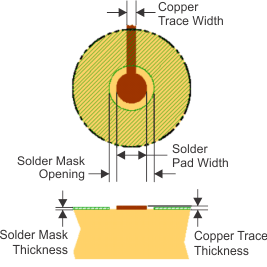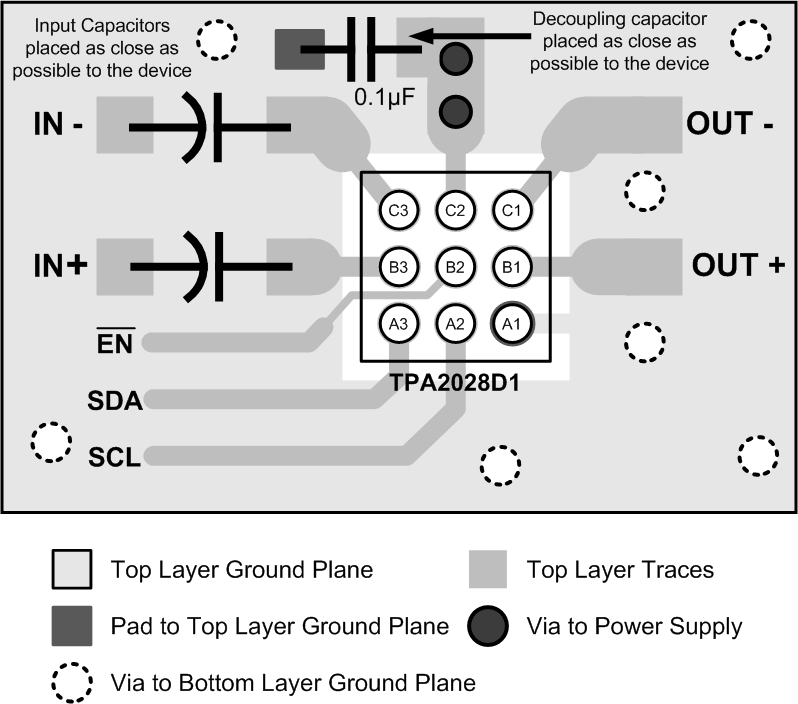SLOS660C January 2010 – October 2015 TPA2028D1
PRODUCTION DATA.
- 1 Features
- 2 Applications
- 3 Description
- 4 Revision History
- 5 Device Comparison Table
- 6 Pin Configuration and Functions
- 7 Specifications
- 8 Parameter Measurement Information
- 9 Detailed Description
- 10Application and Implementation
- 11Power Supply Recommendations
- 12Layout
- 13Device and Documentation Support
- 14Mechanical, Packaging, and Orderable Information
Package Options
Mechanical Data (Package|Pins)
- YZF|9
Thermal pad, mechanical data (Package|Pins)
Orderable Information
12 Layout
12.1 Layout Guidelines
12.1.1 Component Placement
Place all the external components very close to the TPA2028D1. Placing the decoupling capacitor, CS, close to the TPA2028D1 is important for the efficiency of the Class-D amplifier. Any resistance or inductance in the trace between the device and the capacitor can cause a loss in efficiency.
12.1.2 Trace Width
Recommended trace width at the solder balls is 75 μm to 100 μm to prevent solder wicking onto wider PCB traces. For high current pins (PVDD (L, R), PGND, and audio output pins) of the TPA2028D1, use 100-μm trace widths at the solder balls and at least 500-μm PCB traces to ensure proper performance and output power for the device. For the remaining signals of the TPA2028D1, use 75-μm to 100-μm trace widths at the solder balls. The audio input pins (IN+ and IN–) must run side-by-side to maximize common-mode noise cancellation
12.1.3 Pad Size
In making the pad size for the DSBGA balls, TI recommends that the layout use non solder mask defined (NSMD) land. With this method, the solder mask opening is made larger than the desired land area, and the opening size is defined by the copper pad width. Figure 50 and Table 15 shows the appropriate diameters for a DSBGA layout. The TPA2028D1 evaluation module (EVM) layout is shown in the next section as a layout example.
 Figure 50. Land Pattern Dimensions
Figure 50. Land Pattern Dimensions
Table 15. Land Pattern Dimensions(1) (2) (3) (4)
| SOLDER PAD DEFINITIONS | COPPER PAD | SOLDER MASK(5) OPENING | COPPER THICKNESS | STENCIL(6) (7) OPENING | STENCIL THICKNESS |
|---|---|---|---|---|---|
| Non solder mask defined (NSMD) | 275 μm (+0.0, –25 μm) |
375 μm (+0.0, –25 μm) |
1 oz max (32 μm) | 275 μm × 275 μm Sq. (rounded corners) | 125 μm thick |
12.2 Layout Example
 Figure 51. TPA2028D1 Layout Example
Figure 51. TPA2028D1 Layout Example
12.3 Efficiency and Thermal Considerations
The maximum ambient temperature depends on the heat-sinking ability of the PCB system. The derating factor for the packages are shown in the dissipation rating table. Converting this to θJA for the DSBGA package:

Given θJA of 105°C/W, the maximum allowable junction temperature of 150°C, and the maximum internal dissipation of 0.4 W for 3 W output power, 4-Ω load, 5-V supply, from Figure 17, the maximum ambient temperature can be calculated with the following equation.

Equation 8 shows that the calculated maximum ambient temperature is 108°C at maximum power dissipation with a 5-V supply and 4-Ω a load. The TPA2028D1 is designed with thermal protection that turns the device off when the junction temperature surpasses 150°C to prevent damage to the IC. Also, using speakers more resistive than 8-Ω dramatically increases the thermal performance by reducing the output current and increasing the efficiency of the amplifier.